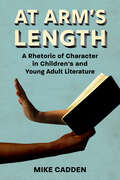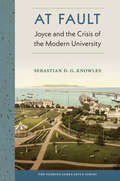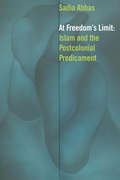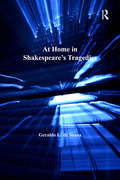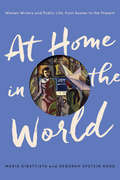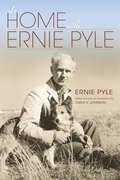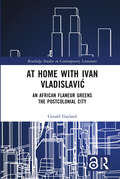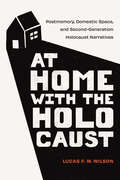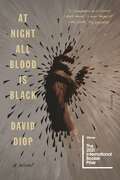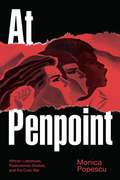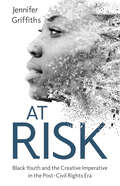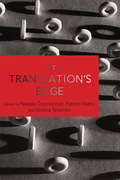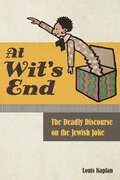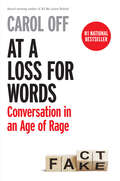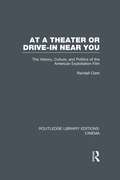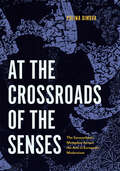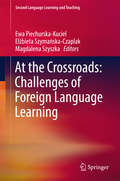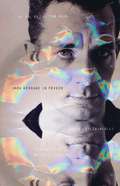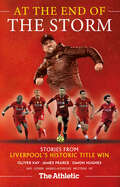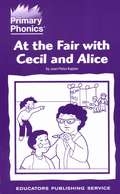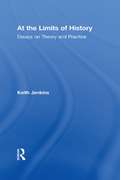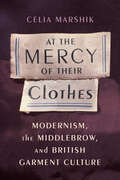- Table View
- List View
At Arm’s Length: A Rhetoric of Character in Children’s and Young Adult Literature (Children's Literature Association Series)
by Mike CaddenLiterary critics and authors have long argued about the importance or unimportance of an author’s relationship to readers. What can be said about the rhetorical relationship that exists between author and reader? How do authors manipulate character, specifically, to modulate the emotional appeal of character so a reader will feel empathy, awe, even delight? In At Arm’s Length: A Rhetoric of Character in Children's and Young Adult Literature, Mike Cadden takes a rhetorical approach that complements structural, affective, and cognitive readings. The study offers a detailed examination of the ways authorial choice results in emotional invitation. Cadden sounds the modulation of characters along a continuum from those larger than life and awe inspiring to the life sized and empathetic, down to the pitiable and ridiculous, and all those spaces between. Cadden examines how authors alternate between holding the young reader at arm’s length from and drawing them into emotional intensity. This balance and modulation are key to a rhetorical understanding of character in literature, film, and television for the young. Written in accessible language and of interest and use to undergraduates and seasoned critics, At Arm’s Length provides a broad analysis of stories for the young child and young adult, in book, film, and television. Throughout, Cadden touches on important topics in children’s literature studies, including the role of safety in children’s media, as well as character in multicultural and diverse literature. In addition to treating “traditional” works, he analyzes special cases—forms, including picture books, verse novels, and graphic novels, and modes like comedy, romance, and tragedy.
At Fault: Joyce and the Crisis of the Modern University (The Florida James Joyce Series)
by Sebastian D.G. KnowlesAt Fault is an exhilarating celebration of risk-taking in the work of James Joyce. Esteemed Joyce scholar and teacher Sebastian Knowles critiques the state of the modern American university, denouncing what he sees as an accelerating trend of corporatization that is repressing discussions of controversial ideas and texts in the classroom. Arguing that Joyce offers the antidote to risk-averse attitudes in higher education, he shows how the modernist writer models an openness to being "at fault" that should be central to the academic enterprise. Knowles describes Joyce's writing style as an "outlaw language" imbued with the possibility and acknowledgment of failure. He demonstrates that Joyce's texts and characters display a drive to explore the boundaries of experience, to move outward in a centrifugal pattern, to defy delimitation. Knowles further highlights the expansiveness of Joyce’s world by engaging a diverse range of topics, including Jumbo the elephant as a symbol of imperialism, the gramophone as a representation of the machine age, solfège and live music performance in the "Sirens" episode of Ulysses, Joyce's jokes and the neurology of humor, and inventive ways of reading and teaching Finnegans Wake. Contending that error is the central theme in all of Joyce's work, Knowles argues that the freedom to challenge boundaries and make mistakes is essential to an effective learning environment. Energetic and delightfully erudite, and offering insights drawn from over thirty years of classroom experience, Knowles inspires readers with the infinite possibilities of free human thought exemplified by Joyce's writing. A volume in the Florida James Joyce Series, edited by Sebastian D. G. Knowles
At Freedom's Limit: Islam and the Postcolonial Predicament
by Sadia AbbasThe subject of this book is a new “Islam.” This Islam began to take shape in 1988 around the Rushdie affair, the collapse of the Berlin Wall in 1989, and the first Gulf War of 1991. It was consolidated in the period following September 11, 2001. It is a name, a discursive site, a signifier at once flexible and constrained—indeed, itis a geopolitical agon, in and around which some of the most pressing aporias of modernity, enlightenment, liberalism, and reformation are worked out.At this discursive site are many metonyms for Islam: the veiled or “pious” Muslim woman, the militant, the minority Muslim injured by Western free speech. Each of these figures functions as a cipher enabling repeated encounters with the question “How do we free ourselves from freedom?” Again and again, freedom is imagined as Western, modern, imperial—a dark imposition of Enlightenment. The pious and injured Muslim who desires his or her own enslavement is imagined as freedom’s other.At Freedom’s Limit is an intervention into current debates regarding religion, secularism, and Islam and provides a deep critique of the anthropology and sociology of Islam that have consolidated this formation. It shows that, even as this Islam gains increasing traction in cultural production from television shows to movies to novels, the most intricate contestations of Islam so construed are to be found in the work of Muslim writers and painters.This book includes extended readings of jihadist proclamations; postcolonial law; responses to law from minorities in Muslim-majority societies; Islamophobic films; the novels of Leila Aboulela, Mohammed Hanif, and Nadeem Aslam; and the paintings of Komail Aijazuddin.
At Home in Shakespeare's Tragedies
by Geraldo U. SousaBringing together methods, assumptions and approaches from a variety of disciplines, Geraldo U. de Sousa's innovative study explores the representation, perception, and function of the house, home, household, and family life in Shakespeare's great tragedies. Concentrating on King Lear, Hamlet, Othello, and Macbeth, de Sousa's examination of the home provides a fresh look at material that has been the topic of fierce debate. Through a combination of textual readings and a study of early modern housing conditions, accompanied by analyses that draw on anthropology, architecture, art history, the study of material culture, social history, theater history, phenomenology, and gender studies, this book demonstrates how Shakespeare explores the materiality of the early modern house and evokes domestic space to convey interiority, reflect on the habits of the mind, interrogate everyday life, and register elements of the tragic journey. Specific topics include the function of the disappearance of the castle in King Lear, the juxtaposition of home-centered life in Venice and nomadic, 'unhoused' wandering in Othello, and the use of special lighting effects to reflect this relationship, Hamlet's psyche in response to physical space, and the redistribution of domestic space in Macbeth. Images of the house, home, and household become visually and emotionally vibrant, and thus reflect, define, and support a powerful tragic narrative.
At Home in the World: Women Writers and Public Life, from Austen to the Present
by Maria Dibattista Deborah Epstein NordIn a bold and sweeping reevaluation of the past two centuries of women's writing, At Home in the World argues that this body of work has been defined less by domestic concerns than by an active engagement with the most pressing issues of public life: from class and religious divisions, slavery, warfare, and labor unrest to democracy, tyranny, globalism, and the clash of cultures. In this new literary history, Maria DiBattista and Deborah Epstein Nord contend that even the most seemingly traditional works by British, American, and other English-language women writers redefine the domestic sphere in ways that incorporate the concerns of public life, allowing characters and authors alike to forge new, emancipatory narratives.The book explores works by a wide range of writers, including canonical figures such as Jane Austen, Charlotte Brontë, George Eliot, Harriet Jacobs, Edith Wharton, Virginia Woolf, Willa Cather, Gertrude Stein, and Toni Morrison; neglected or marginalized writers like Mary Antin, Tess Slesinger, and Martha Gellhorn; and recent and contemporary figures, including Nadine Gordimer, Anita Desai, Edwidge Danticat, and Jhumpa Lahiri. DiBattista and Nord show how these writers dramatize tensions between home and the wider world through recurrent themes of sailing forth, escape, exploration, dissent, and emigration. Throughout, the book uncovers the undervalued public concerns of women writers who ventured into ever-wider geographical, cultural, and political territories, forging new definitions of what it means to create a home in the world.The result is an enlightening reinterpretation of women's writing from the early nineteenth century to the present day.
At Home with Ernie Pyle
by Owen V. Johnson Ernie PyleAs anyone who has read his legendary WWII reporting knows, Ernie Pyle had an uncanny ability to connect with his readers, seeking out stories about the common people with whom he felt a special bond. A master of word painting, Pyle honed the skills that would win him a 1944 Pulitzer Prize for his battlefront reporting by traveling across America, writing columns about the people and places he encountered. At Home with Ernie Pyle celebrates Pyle's Indiana roots, gathering for the first time his writings about the state and its people. These stories preserve a vivid cultural memory of his time. In them, we discover the Ernie Pyle who was able to find a piece of home wherever he wandered. By focusing on his family and the lives of people in and from the Hoosier state, Pyle was able to create a multifaceted picture of the state as it slowly transformed from a mostly rural, agrarian society to a modern, industrial one. Here is the record of a special time and place created by a master craftsman, whose work remains vividly alive three quarters of a century later.
At Home with Ivan Vladislavić: An African Flaneur Greens the Postcolonial City (Routledge Studies in Contemporary Literature)
by Gerald GaylardAt Home With Ivan Vladislavić is the first comprehensive analysis of the works of Ivan Vladislavić. Bringing a flaneur’s "internal GPS" to postcolonial Johannesburg, Vladislavić established a critical sense of home via an intimate knowledge of geography and history. This sense of belonging can have positive ecological effects as we tend to protect what we know. The flaneur’s deep word hoard also helped him to develop a minimalist style, which was not only a means of living sustainably in the city, but in its humour and close attention to detail a way to make greening the city more of a joy than a duty. In this way, Vladislavić created a culture of sustainability.
At Home with the Holocaust: Postmemory, Domestic Space, and Second-Generation Holocaust Narratives
by Lucas F. WilsonAt Home with the Holocaust examines the relationship between intergenerational trauma and domestic space, focusing on how Holocaust survivors’ homes became extensions of their traumatized psyches that their children “inhabited.” Analyzing second- and third-generation Holocaust literature—such as Art Spiegelman's Maus, Jonathan Safran Foer's Everything Is Illuminated, Sonia Pilcer's The Holocaust Kid, and Elizabeth Rosner's The Speed of Light—as well as oral histories of children of survivors, Lucas F. W. Wilson's study reveals how the material conditions of survivor-family homes, along with household practices and belongings, rendered these homes as spaces of traumatic transference. As survivors’ traumas became imbued in the very space of the domestic, their homes functioned as material archives of their Holocaust pasts, creating environments that, not uncommonly, second-handedly wounded their children. As survivor-family homes were imaginatively transformed by survivors’ children into the sites of their parents’ traumas, like concentration camps and ghettos, their homes catalyzed the transmission of these traumas.
At Night All Blood Is Black: A Novel
by David DiopSelected by students across France to win the Prix Goncourt des Lycéens, David Diop’s English-language, historical fiction debut At Night All Blood is Black is a “powerful, hypnotic, and dark novel” (Livres Hebdo) of terror and transformation in the trenches of the First World War. <p><p> Alfa Ndiaye is a Senegalese man who, never before having left his village, finds himself fighting as a so-called “Chocolat” soldier with the French army during World War I. When his friend Mademba Diop, in the same regiment, is seriously injured in battle, Diop begs Alfa to kill him and spare him the pain of a long and agonizing death in No Man’s Land. <p><p> Unable to commit this mercy killing, madness creeps into Alfa’s mind as he comes to see this refusal as a cruel moment of cowardice. Anxious to avenge the death of his friend and find forgiveness for himself, he begins a macabre ritual: every night he sneaks across enemy lines to find and murder a blue-eyed German soldier, and every night he returns to base, unharmed, with the German’s severed hand. At first his comrades look at Alfa’s deeds with admiration, but soon rumors begin to circulate that this super soldier isn’t a hero, but a sorcerer, a soul-eater. Plans are hatched to get Alfa away from the front, and to separate him from his growing collection of hands, but how does one reason with a demon, and how far will Alfa go to make amends to his dead friend? <p><p> Peppered with bullets and black magic, this remarkable novel fills in a forgotten chapter in the history of World War I. Blending oral storytelling traditions with the gritty, day-to-day, journalistic horror of life in the trenches, David Diop's At Night All Blood is Black is a dazzling tale of a man’s descent into madness.
At Penpoint: African Literatures, Postcolonial Studies, and the Cold War (Theory in Forms)
by Monica PopescuIn At Penpoint Monica Popescu traces the development of African literature during the second half of the twentieth century to address the intertwined effects of the Cold War and decolonization on literary history. Popescu draws on archival materials from the Soviet-sponsored Afro-Asian Writers Association and the CIA-funded Congress for Cultural Freedom alongside considerations of canonical literary works by Ayi Kwei Armah, Ngũgĩ wa Thiong'o, Ousmane Sembène, Pepetela, Nadine Gordimer, and others. She outlines how the tensions between the United States and the Soviet Union played out in the aesthetic and political debates among African writers and intellectuals. These writers decolonized aesthetic canons even as superpowers attempted to shape African cultural production in ways that would advance their ideological and geopolitical goals. Placing African literature at the crossroads of postcolonial theory and studies of the Cold War, Popescu provides a new reassessment of African literature, aesthetics, and knowledge production.
At Risk: Black Youth and the Creative Imperative in the Post–Civil Rights Era (Cultures of Childhood)
by Jennifer GriffithsJennifer Griffiths's At Risk: Black Youth and the Creative Imperative in the Post–Civil Rights Era focuses on literary representations of adolescent artists as they develop strategies to intervene against the stereotypes that threaten to limit their horizons. The authors of the analyzed works capture and convey the complex experience of the generation of young people growing up in the era after the civil rights movement. Through creative experiments, they carefully consider what it means to be narrowed within the scope of a sociological “problem,” all while trying to expand the perspective of creative liberation. In short, they explore what it means to be deemed an “at risk” youth. This book looks at crucial works beginning in 1968, ranging from Sapphire’s Push and The Kid, Walter Dean Myers’s Monster, and Dael Orlandersmith’s The Gimmick, to Bill Gunn’s Johnnas. Each text offers unique representations of Black gifted children, whose creative processes help them to navigate simultaneous hypervisibility and invisibility as racialized subjects. The book addresses the ways that adolescents experience the perilous “at risk” label, which threatens to narrow adolescent existence at a developmental moment that requires an orientation toward possibility and a freedom to experiment. Ultimately, At Risk considers the distinct possibilities and challenges of the post–civil rights era, and how the period allows for a more honest, multilayered, and forthright depiction of Black youth subjectivity against the adultification that forecloses potential.
At Translation's Edge (Media Matters)
by Suzanne Jill Levine Russell Scott Valentino John Cayley Lydia H Liu Naoki Sakai Deborah Folaron Margaret A Noodin Yiman Wang Martha Pulido Olga Behar Elizabeth R Drame Lorena TerandoSince the 1970s, the field of Translation Studies has entered into dialogue with an array of other disciplines, sustaining a close but contentious relationship with literary translation. At Translation’s Edge expands this interdisciplinary dialogue by taking up questions of translation across sub-fields and within disciplines, including film and media studies, comparative literature, history, and education among others. For the contributors to this volume, translation is understood in its most expansive, transdisciplinary sense: translation as exchange, migration, and mobility, including cross-cultural communication and media circulation. Whether exploring the Universal Declaration of Human Rights or silent film intertitles, this volume brings together the work of scholars aiming to address the edges of Translation Studies while engaging with major and minor languages, colonial and post-colonial studies, feminism and disability studies, and theories of globalization and empire.
At Vanity Fair
by Kirsty MilneAt Vanity Fair tells the story of Bunyan's powerful metaphor, exploring how Vanity Fair was transformed from an emblem of sin and persecution into a showcase for celebrity, wealth and power. This literary history, focusing on reception, adaptation and influence, traces the fictional representation of Vanity Fair over three centuries from John Bunyan's masterpiece, The Pilgrim's Progress (1678), to William Makepeace Thackeray's own Vanity Fair (1847–8). It explores the influence of anonymous journalists and booksellers alongside well-known authors including Ben Jonson, Samuel Richardson and Thomas Carlyle. Over time, Bunyan's dystopian fantasy has been altered and repurposed to characterise consumer capitalism, channelling memories that inform and unsettle modern hedonism. By tracking the idea of 'Vanity Fair' against this shifting background, the book illuminates the relationship between the individual and the collective imagination, between what is culturally available and what is creatively impelled.
At Wit's End: The Deadly Discourse on the Jewish Joke
by Louis KaplanCHOICE: OUTSTANDING ACADEMIC TITLEA scholarly and thought-provoking work that places Jewish humor at the center of a discourse about Jewish and German relations through most of the twentieth century.At Wit’s End explores the fascinating discourse on Jewish wit in the twentieth century when the Jewish joke became the subject of serious humanistic inquiry and inserted itself into the cultural and political debates among Germans and Jews against the ideologically charged backdrop of anti-Semitism, the Jewish question, and the Holocaust.The first in-depth study to explore the Jewish joke as a crucial rhetorical figure in larger cultural debates in Germany, author Louis Kaplan presents an engrossing and lucid work of scholarship that examines how “der jüdische Witz” (referring to both Jewish wit and jokes) was utilized differently in a number of texts, from the Weimar Republic to the rise of National Socialism, and how it was re-introduced into the public sphere after the Holocaust with the controversial publication of Salcia Landmann’s collection of Jewish jokes in the reparations era (Wiedergutmachung). Kaplan reviews the claims made about the Jewish joke and its provocative laughter by notable writers from a variety of ideological perspectives, demonstrating how their reflections on this complex cultural trope enable a better understanding of German–Jewish intercultural relations and their eventual breakdown in the Third Reich. He also illustrates how selfcritical and self-ironic Jewish Witz maintained a fraught and ambivalent relationship with anti-Semitism.In reviewing this critical and traumatic moment in modern German–Jewish history through the deadly discourse on the Jewish joke, At Wit’s End includes chapters on the virulent Austrian anti-Semitic racial theorist Arthur Trebitsch, the Nazi racial propagandist Siegfried Kadner, the German Marxist cultural historian Eduard Fuchs, the Jewish diasporic historian Erich Kahler, and the Jewish cabaret impresario Kurt Robitschek, among others. Shedding new light on anti-Semitism and on the Jewish question leading up to the Holocaust, At Wit’s End provides readers with a unique perspective by which to gain important insights about this crucial historical period that reverberates into the present day, when potentially offensive humor coupled with a toxic political climate and xenophobia can have deadly consequences.
At a Loss for Words: Conversation in the Age of Rage
by Carol OffAN INSTANT #1 NATIONAL BESTSELLER Award-winning author and broadcast journalist Carol Off digs deep into six words whose meanings have been distorted and weaponized in recent years—including democracy, freedom and truth—and asks whether we can reclaim their value.As co-host of CBC Radio's As It Happens, Carol Off spent a decade and a half talking to people in the news five nights a week. On top of her stellar writing and reporting career, those 25,000 interviews have given her a unique vantage point on the crucial subject at the heart of her new book—how, in these polarizing years, words that used to define civil society and social justice are being put to work for a completely different political agenda. Or they are being bleached of their meaning as the values they represent are mocked and distorted. As Off writes, &“If our language doesn&’t have a means to express an idea, then the idea itself is gone—even the range of thought is diminished.&” And, as she argues, that&’s a dangerous loss.In six, wide-ranging chapters, Off explores the mutating meanings and the changing political impact of her six chosen words—freedom, democracy, truth, woke, choice and taxes—unpacking the forces, from right and left, that have altered them beyond recognition. She also shows what happens when we lose our shared political vocabulary: we stop being able to hear each other, let alone speak with each other in meaningful ways. This means we stop being able to reckon with the complexity of the crises we face, leaving us prey to conspiracy theories, autocrats and the machinations of greed. At a Loss for Words is both an elegy and a call to arms.
At a Theater or Drive-in Near You: The History, Culture, and Politics of the American Exploitation Film (Routledge Library Editions: Cinema)
by Randall ClarkMillions of Americans have been thrilled, scared, titillated, and shocked by exploitation movies, low budget films with many scenes of sex, violence, and other potentially lurid elements. The term derives from the fact that promoters of such films exploit the contents in advertising that plays up the sexual or violent aspects of the films. This is the first comprehensive study of the American exploitation film to be published. It discusses five distinct genres: the teen movie, the sexploitation film, the martial arts movie, the blaxploitation film and the lawbreaker picture. Contained within these genres are many popular American film types, including beach movies, biker pictures, and women's prison movies. The study provides a history and sociopolitical analysis of each genre, focusing on significant films in those genres. It also discusses the economics of exploitation films and their place in the motion picture industry, the development of drive-in theaters, the significance of the teenage audience, and the effect of the videocassette. Finally, the book applies major film and cultural theories to establish an aesthetic for evaluating the exploitation film and to explore the relationship between film and audience.
At the Borders of Sleep: On Liminal Literature
by Peter SchwengerAt the Borders of Sleep is a unique exploration of the connections between literature and the liminal states between waking and sleeping—from falling asleep and waking up, to drowsiness and insomnia, to states in which sleeping and waking mix. Delving into philosophy as well as literature, Peter Schwenger investigates the threshold between waking and sleeping as an important and productive state between the forced march of rational thought and the oblivion of unconsciousness.While examining literary representations of the various states between waking and sleeping, At the Borders of Sleep also analyzes how writers and readers alike draw on and enter into these states. To do so Schwenger reads a wide range of authors for whom the borders of sleep are crucial, including Marcel Proust, Stephen King, Paul Valéry, Fernando Pessoa, Franz Kafka, Giorgio de Chirico, Virginia Woolf, Philippe Sollers, and Robert Irwin. Considering drowsiness, insomnia, and waking up, he looks at such subjects as the hypnagogic state, the experience of reading and why it is different from full consciousness, the relationships between insomnia and writing and why insomnia is often a source of creative insight, and the persistence of liminal elements in waking thought. A final chapter focuses on literature that blurs dream and waking life, giving special attention to experimental writing.Ultimately arguing that, taking place on the edges of consciousness, both the reading and writing of literature are liminal experiences, At the Borders of Sleep suggests new ways to think about the nature of literature and consciousness.
At the Crossroads of the Senses: The Synaesthetic Metaphor Across the Arts in European Modernism (Perspectives on Sensory History)
by Polina DimovaInspired by Richard Wagner’s idea of the total artwork, European modernist artists began to pursue multimedia projects that mixed colors, sounds, and shapes. Polina Dimova’s At the Crossroads of the Senses traces this new sensory experience of synaesthesia—the physiological or figurative blending of senses—as a modernist phenomenon from its scientific description in the late nineteenth century to its prevalence in the early twentieth.Structured around twenty theses on synaesthesia, this book explores the integral relationship between modernist art, science, and technology, tracing not only how modernist artists perceptually internalized and absorbed technology and its effects but also how they appropriated it to achieve their own aesthetic, metaphysical, and social goals. Through case studies of prominent multimodal artists—Oscar Wilde, Aubrey Beardsley, Richard Strauss, Aleksandr Scriabin, Wassily Kandinsky, František Kupka, Andrei Bely, and Rainer Maria Rilke—At the Crossroads of the Senses reveals the color-forms and color-sounds that, for these artists, laid the foundations of the world and served as the catalyst for the flourishing exchanges among the arts at the fin de siècle.Rooted in archival research in Russia, Germany, France, and the Czech Republic, At the Crossroads of the Senses taps overlooked scientific sources to offer a fresh perspective on European modernism. Sensory studies scholars, literary critics, and art and music historians alike will welcome its many contributions, not least among them a refreshing advocacy for a kind of sensuous reading practice.
At the Crossroads: Challenges of Foreign Language Learning (Second Language Learning and Teaching)
by Ewa Piechurska-Kuciel Magdalena Szyszka Elżbieta Szymańska-CzaplakThis book offers a valuable contribution to the discussion on the complexities of L2 learning processes that pose a challenge to learners. Focusing on the cognitive, affective and socio-cultural perspectives, the papers included provide important insights into the individual's experiences in second language acquisition. This work also addresses social interactions and cultural background, shedding new light on their role in the context in L2 learning processes. It is a valuable resource for anyone interested in understanding the challenges of foreign-language (FL) learning and teaching.
At the End of the Road: Jack Kerouac in Mexico
by Jorge García-Robles&“We had finally found the magic land at the end of the road and we never dreamed the extent of the magic.&” Mexico, an escape route, inspiration, and ecstatic terminus of the celebrated novel On the Road, was crucial to Jack Kerouac&’s creative development. In this dramatic and highly compelling account, Jorge García-Robles, leading authority on the Beats in Mexico, re-creates both the actual events and the literary imaginings of Kerouac in what became the writer&’s revelatory terrain. Providing Kerouac an immediate spiritual freshness that contrasted with the staid society of the United States, Mexico was perhaps the single most important country in his life. Sourcing material from the Beat author&’s vast output and revealing correspondence, García-Robles vividly describes the milieu and people that influenced him while sojourning there and the circumstances between his myriad arrivals and departures. From the writer&’s initial euphoria upon encountering Mexico and its fascinating tableau of humanity to his tortured relationship with a Mexican prostitute who inspired his novella Tristessa, this volume chronicles Kerouac&’s often illusory view of the country while realistically detailing the incidents and individuals that found their way into his poetry and prose. In juxtaposing Kerouac&’s idyllic image of Mexico with his actual experiences of being extorted, assaulted, and harassed, García-Robles offers the essential Mexican perspective. Finding there the spiritual nourishment he was starved for in the United States, Kerouac held fast to his idealized notion of the country, even as the stories he recounts were as much literary as real.
At the End of the Storm: Stories from Liverpool's Historic Title Win
by James Pearce Simon Hughes Oliver KayA collection of articles from the writers of The Athletic detailing Liverpool F.C.’s 2019–2020 championship season.As Liverpool ended their thirty-year wait to be crowned champions of England, they were followed by their equivalent from the world of sports writing: a team of elite talents, assembled to leave all competition trailing in their wake. This is the story of Liverpool’s title win in the longest season, as told by the writers of The Athletic, with their blend of inside access and expert analysis; great ideas and beautiful writing.Articles include profiles of each of Liverpool’s title winners by their former youth team coaches; Oliver Kay watches Sadio Mane score against Manchester City in the company of the striker’s family, in his hometown in Senegal; James Pearce spends 90 minutes analysing Virgil van Dijk; plus there are exclusive interviews with Jurgen Klopp, and the club’s US owners.Read the stories behind a unique and historical season from a team of writers every bit as good as the footballers they were following.
At the Fair with Cecil and Alice
by Joan Fleiss KaplanAt the Fair with Cecil and Alice Set 6 Book 1
At the Limits of History: Essays on Theory and Practice
by Keith Jenkins"Why bother with history? Keith Jenkins has an answer. He helps us re-think the "end of history", as signalled by postmodernity. Readers may disagree with him, but he never fails to provoke debate about the future of the past." Joanna Bourke, Professor of History, Birkbeck College Keith Jenkins’ work on historical theory is renowned; this collection presents the essential elements of his work over the last fifteen years. Here we see Jenkins address the difficult and complex question of defining the limits of history. The collection draws together the key pieces of his work in one handy volume, encompassing the ever controversial issue of postmodernism and history, questions on the end of history and radical history into the future. Exchanges with Perez Zagorin and Michael Coleman further illuminate the level of debate that has surrounded postmodernism, and which continues to do so. An extended introduction and abstracts which contextualize each piece, together with a foreword by Hayden White and an afterword by Alun Munslow, make this collection essential reading for all those interested in the theory and practice of history and its development over the last few decades.
At the Mercy of Their Clothes: Modernism, the Middlebrow, and British Garment Culture (Modernist Latitudes)
by Celia MarshikIn much of modern fiction, it is the clothes that make the character. Garments embody personal and national histories. They convey wealth, status, aspiration, and morality (or a lack thereof). They suggest where characters have been and where they might be headed, as well as whether or not they are aware of their fate. At the Mercy of Their Clothes explores the agency of fashion in modern literature, its reflection of new relations between people and things, and its embodiment of a rapidly changing society confronted by war and cultural and economic upheaval. In some cases, people need garments to realize themselves. In other cases, the clothes control the person who wears them. <P><P> Celia Marshik's study combines close readings of modernist and middlebrow works, a history of Britain in the early twentieth century, and the insights of thing theory. She focuses on four distinct categories of modern clothing: the evening gown, the mackintosh, the fancy dress costume, and secondhand attire. In their use of these clothes, we see authors negotiate shifting gender roles, weigh the value of individuality during national conflict, work through mortality, and depict changing class structures. <P><P>Marshik's dynamic comparisons put Ulysses in conversation with Rebecca, Punch cartoons, articles in Vogue, and letters from consumers, illuminating opinions about specific garments and a widespread anxiety that people were no more than what they wore. Throughout her readings, Marshik emphasizes the persistent animation of clothing—and objectification of individuals—in early-twentieth-century literature and society. She argues that while artists and intellectuals celebrated the ability of modern individuals to remake themselves, a range of literary works and popular publications points to a lingering anxiety about how political, social, and economic conditions continued to constrain the individual.
